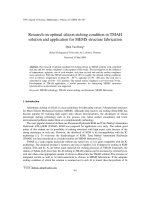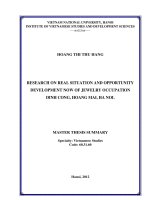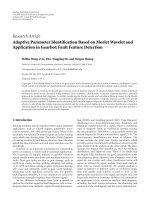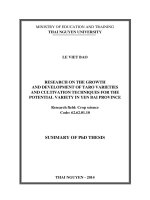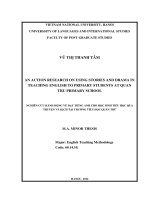Research on operation mechanism and application in engineering of UNITANK process
Bạn đang xem bản rút gọn của tài liệu. Xem và tải ngay bản đầy đủ của tài liệu tại đây (294.7 KB, 6 trang )
Research on Operation Mechanism and Application in Engineering of
UNITANK Process
Dong-jie BAO
1, a,*
, Jing LI
2,b
and Peng ZHANG
3,c
1
Xingtai Polytechnic College, Xingtai, Hebei, 054035, China
2
Xingtai Polytechnic College, Xingtai, Hebei, 054035, China
3
Xingtai Polytechnic College, Xingtai, Hebei, 054035, China
a
,
b
,
c
*Corresponding author
Keywords: UNITANK Process, Operation Mechanism, Wastewater Treatment.
Abstract. UNITANK is a new wastewater treatment technology combining the advantages of
Sequencing Batch Reactor, normal aeration tank and 3-ditch oxidation treatment systems. It has been
considered as an attractive pathway to be applied in small or middle wastewater treatment plants. It
was chosen as the main process in Xingtai Wastewater Treatment Plant, Hebei Province, PR China. In
this paper, the operation process, operation mechanism and features of UNITANK process were
discussed in detail on the basis of the basic structure and the application in engineering.
Basic Structure of UNITANK Reactor
UNITANK process, named the alternating biological treatment technology, is also called the single
pool system. It is the patent technology of Seghers Engineering Water NV in the late 80’s. There are
three lattices (also known as tank A, B and C) in one pool. The tanks share the public wall and
hydraulic connect with each other through the public channel at the bottom. Outlets of the public
channel belonging to the side tanks are located in the center of the tanks. Stabilizing covers are set
above the outlets to prevent the disturbance of the sludge. There is a set aeration system in each tank.
The fixed effluent weirs and sludge slots are arranged in the outside two tanks (A, C tank) .Tanks A
and C are used as the aeration tank and the settling tank alternately, while tank B is only used as a
aeration tank [1-3]. It is a continuous influent and alternate working system, which is shown in Fig.1
Engineering Application in Xingtai Wastewater Treatment Plant
Overview of the Project
In the secondary project of Xingtai Wastewater Treatment Plant,the capacity of UNITANK
process is 10xl0
4
m
3
/d. The quality of influent and the designed quality of effluent is shown in Table 1.
The designed quality of effluent achieves the secondary standard of "Discharge Standard of Pollutants
for Municipal Wastewater Treatment Plant" (GB18918-2002,China).
Table 1. The Quality of Influent and the Designed Quality of Effluent
items BOD
5
COD SS T-N NH
3
-N T-P
influent [mg/L] 123~229 267~376 105~245 33~52 22~41 1.91~3.99
average influent[mg/L] 186 326 201 46 33 3.3
effluent [mg/L] ≤30 ≤100 ≤30 ≤30 ≤25 ≤3.0
Advanced Materials Research Vol. 937 (2014) pp 370-374
Online available since 2014/May/07 at www.scientific.net
© (2014) Trans Tech Publications, Switzerland
doi:10.4028/www.scientific.net/AMR.937.370
All rights reserved. No part of contents of this paper may be reproduced or transmitted in any form or by any means without the written permission of TTP,
www.ttp.net. (ID: 130.159.18.180, University of Strathclyde, Glasgow, United Kingdom-06/10/14,05:21:40)
Technical Process
The technical Process is shown in Fig.2. The layout of the tanks is shown in Fig.3.
Parameters of the Project
There are four groups of UNITANK reactor, each group contains three rectangular tanks marked A,
B and C. Parameters of the project is shown in Table 2.
Fig. 1. Basic Structure of UNITANK Reactor
Fig. 2. The Technical Process of the Secondary Project
Advanced Materials Research Vol. 937 371
Fig. 3. The Layout of the Tanks
Table 2. The Parameters of the Project
Tank A Tank B Tank C
size [m] 32x32x5 (depth) 32x15x5 (depth) 32x32x5 (depth)
effective depth [m] 4 4 4
treatment capacity [m
3
/d] 2.5xl0
4
volumetric load [kg BOD/ (m
3
·d)] 0.33
sludge load [kgBOD/(kgMLVSS·d)] 0.104
surface load [m
3
/(m
2
·h)] 1.02
weir load [L/(s·m)] 1.55
sludge concentration [kg/m
3
] 4
aerobic sludge age [d] 9
hydraulic retention time [h] 9.7
Operation Mechanism and Features
Operation Cycle and Timing of the Reactor
The alternating biological reactor operates according to the period of cycle. Each cycle comprises
two main operation stages and two transition stages [4-6]. The two main operation stages are mutually
symmetrical and connected through the transition stage. The operation cycle and timing of the reactor
in Xingtai Wastewater Treatment Plant is shown in Table 3. There are 12 hours in per cycle including
2×4 hours of the main stages and 2×2 hours of the transition stages.
Table 3. Operation Cycle and Timing of the Reactor
stages time [h] tank A tank B tank C
main
stage
1
stage 1 4.0
influent, aeration
aeration settling, effluent
stage 2 0.5 aeration influent, aeration settling, effluent
stage 3 1.5 settling influent, aeration settling, effluent
main
stage
2
stage 4 4.0 settling, effluent aeration influent, aeration
stage 5 0.5 settling, effluent influent, aeration aeration
stage 6 1.5 settling, effluent influent, aeration settling
372 Material Science and Environmental Engineering
Operation Mechanism and Feature
The Operation mechanism is shown in Fig.4. In Fig.4, the stages and the state of each tank are
displayed in detail.
The System Has Characteristics of High Efficiency
The system is more suitable for treating wastewater with high concentration than the general
activated sludge methods. The sewage flowing into the side tank will be better handled because there
is a great quantity of activated sludge with high concentration in the tank [7]. This is due to the
operation as a sedimentation pool in the last stage of the cycle. With continuous flowing,
concentration of pollutant in liquid phase increases while the absorption and oxidation capacity of
activated sludge is also constantly strengthened. Pollutant is adsorbed and degraded in a relatively
short time.
The System Has a Certain Removal Function of Nitrogen and Phosphorus
The system would have nitrogen and phosphorus removal function by setting the non aeration stage
during the aeration period in order to form the alternate states of anaerobic, anoxic and aerobic and by
controlling the technical conditions such as the flow, time and cycle.
The System Has the Advantages of Compact Structure, Less Land Occupation and
Cost-efficient
The structure of UNITANK process is compact because the tanks connect with each other through
the public wall. The influent flows through the punches which reduces the head loss. Compared with
the common activated sludge process, it does not need another secondary sedimentation tank and
facilities for sludge returning. The system has the advantages of less land occupation, cost-efficient,
reliable operation and convenient maintenance because of fewer types of equipment.
Fig. 4. The Operation Mechanism
Advanced Materials Research Vol. 937 373
Conclusion
UNITANK is an effective technology for wastewater treatment with the advantages of high
efficiency, certain removal function of Nitrogen and Phosphorus, compact structure, less land
occupation, cost-efficient, reliable operation and convenient maintenance. It has been considered as
an attractive pathway to be applied in small or middle wastewater treatment plants.
Acknowledgements
This work was financially supported by Science and Technology Support Program of Hebei
Province (13273605), the Higher School Science and Technology Foundation of Hebei Province
(QN20131178), Xingtai Science and Technology Support Program (2013ZC234).
References
[1]Henze M, Grady C P L, Gujer Jr et al., in: IAWPRC Scientific and Technical Report No.3,London,
UK,1987.
[2]Henze M, Gujer W, Mino T et al., in: Water Sci Technol, Issue1,Vol.39 (1999), p. 165-182.
[3]Vriens L et al., in: Water,1990, p.52.
[4]Dongjie Bao, Zhanmeng Liu and Jing Li, in: Applied Mechanics and Materials, Vols.361-363
(2013), p. 640-643.
[5]V. N. Samokhin: Design Handbook of Wastewater Systems (Allerton Press, Inc., New York 1997).
[6]Jeffrey A. Nathanso: Basic Environmental Technology: Water Supply, Waste management, and
Pollution Control (Pearson Education., publishing as Prentice Hall 2003).
[7]Fagen Zhang, Junxin Liu, in: Journal of Environmental Sciences, Issue2, Vol.19 (2007), p. 142.
374 Material Science and Environmental Engineering
Material Science and Environmental Engineering
10.4028/www.scientific.net/AMR.937
Research on Operation Mechanism and Application in Engineering of UNITANK Process
10.4028/www.scientific.net/AMR.937.370
DOI References
[2] Henze M, Gujer W, Mino T et al., in: Water Sci Technol, Issue1, Vol. 39 (1999), pp.165-182.
